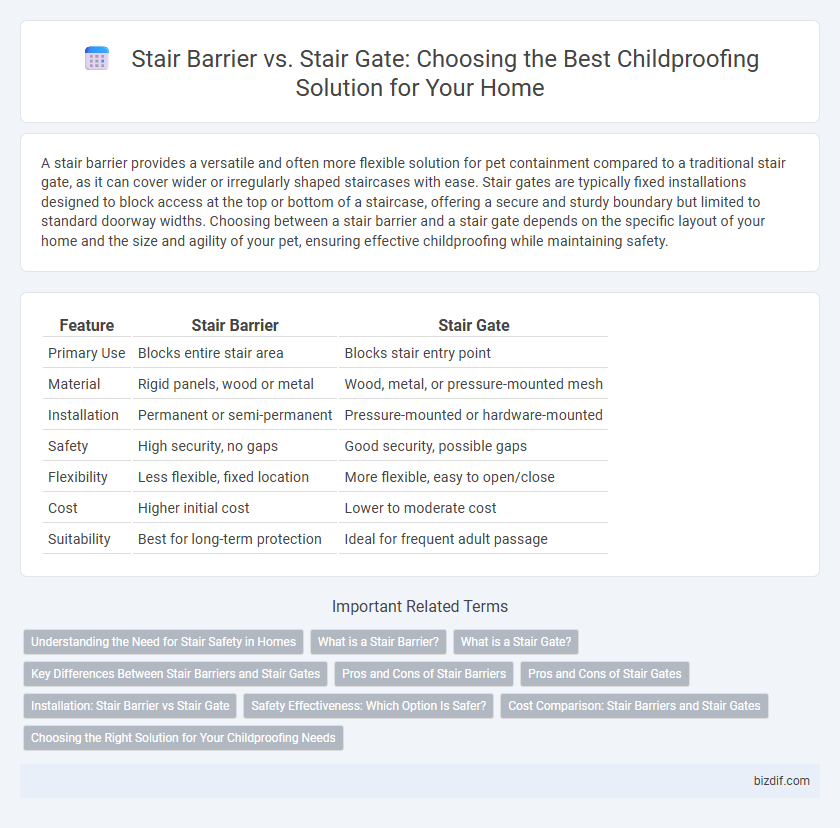A stair barrier provides a versatile and often more flexible solution for pet containment compared to a traditional stair gate, as it can cover wider or irregularly shaped staircases with ease. Stair gates are typically fixed installations designed to block access at the top or bottom of a staircase, offering a secure and sturdy boundary but limited to standard doorway widths. Choosing between a stair barrier and a stair gate depends on the specific layout of your home and the size and agility of your pet, ensuring effective childproofing while maintaining safety.
Table of Comparison
| Feature | Stair Barrier | Stair Gate |
|---|---|---|
| Primary Use | Blocks entire stair area | Blocks stair entry point |
| Material | Rigid panels, wood or metal | Wood, metal, or pressure-mounted mesh |
| Installation | Permanent or semi-permanent | Pressure-mounted or hardware-mounted |
| Safety | High security, no gaps | Good security, possible gaps |
| Flexibility | Less flexible, fixed location | More flexible, easy to open/close |
| Cost | Higher initial cost | Lower to moderate cost |
| Suitability | Best for long-term protection | Ideal for frequent adult passage |
Understanding the Need for Stair Safety in Homes
Stair safety in homes is crucial to prevent falls and injuries among young children, making the choice between stair barriers and stair gates essential. Stair gates offer a secure, removable solution to block access while maintaining visibility and convenience, whereas stair barriers provide a more robust, often permanent restriction. Evaluating the specific needs of the household, such as staircase design and child activity levels, ensures effective childproofing and reduces accident risks.
What is a Stair Barrier?
A stair barrier is a safety device designed to prevent children from accessing staircases, reducing the risk of falls and injuries. Unlike stair gates, which swing or slide open and close, stair barriers typically consist of a fixed or retractable panel that blocks the entire width of the stairway. These barriers are made from durable materials such as wood, metal, or mesh, providing a secure and permanent solution for childproofing stairs.
What is a Stair Gate?
A stair gate is a safety device designed to prevent children from accessing stairways, reducing the risk of falls and injuries. Made from durable materials like wood, metal, or plastic, stair gates can be pressure-mounted or hardware-mounted for secure placement. These gates often feature easy-to-use locking mechanisms for adults, ensuring childproofing without restricting convenience.
Key Differences Between Stair Barriers and Stair Gates
Stair barriers are typically fixed or semi-permanent structures designed to block off entire staircases, offering a robust and wide-ranging solution for child safety. Stair gates are portable, adjustable, and versatile, usually installed at the top or bottom of stairs to temporarily restrict access. Both options prioritize preventing child accidents but differ in installation, mobility, and coverage, with stair barriers providing comprehensive protection and stair gates offering flexible, user-friendly control.
Pros and Cons of Stair Barriers
Stair barriers offer a flexible and often cost-effective solution for childproofing stairs, providing easy installation and removal compared to traditional stair gates. They can be adjusted to fit various stair widths and styles, but may lack the secure locking mechanisms found in stair gates, potentially allowing persistent toddlers to bypass them. However, stair barriers typically require less storage space and can blend more seamlessly with home decor, making them a practical choice for families seeking temporary safety measures.
Pros and Cons of Stair Gates
Stair gates provide a secure physical barrier that is easy to open and close for adults while preventing children from accessing stairs, enhancing home safety. They come in various designs, such as pressure-mounted and hardware-mounted options, offering flexibility in installation but may vary in stability, with pressure-mounted gates being less secure on top of stairs. However, stair gates can create a tripping hazard if not installed properly, and some models may not fit all stair widths, requiring precise measurement for effective childproofing.
Installation: Stair Barrier vs Stair Gate
Stair barriers typically require permanent installation involving screws and brackets into the wall or banister, ensuring a sturdy and durable solution for childproofing stairs. Stair gates often offer both pressure-mounted and hardware-mounted options, with pressure-mounted gates providing easier installation without damaging walls, while hardware-mounted gates provide greater stability. Choosing between a stair barrier and a stair gate depends on the balance needed between installation complexity and long-term security for preventing child access to stairs.
Safety Effectiveness: Which Option Is Safer?
Stair gates provide a secure, installed barrier that prevents children from accessing stairs entirely, ensuring higher safety effectiveness by reducing fall risks. Stair barriers, often temporary and less sturdy, may not fully block access or withstand pushing, making them less reliable for long-term safety. Choosing an installed stair gate offers enhanced protection and peace of mind for parents focused on preventing stair-related accidents in the home.
Cost Comparison: Stair Barriers and Stair Gates
Stair barriers typically cost between $50 and $150, offering a budget-friendly option for basic childproofing needs. Stair gates range from $30 to $200, with higher-end models featuring pressure mounts or hardware installation for increased safety. Comparing costs reveals stair gates provide more versatile price points and enhanced security features, making them a preferred choice for many parents.
Choosing the Right Solution for Your Childproofing Needs
Stair gates provide a secure, removable barrier ideal for temporary or flexible childproofing at staircases, featuring easy installation and adaptable designs for various stair widths. Stair barriers offer a more permanent, robust solution often integrated into existing structures for enhanced safety and durability in high-traffic areas. Evaluating your home's layout, child mobility, and long-term safety requirements ensures selecting the best option between stair gates and stair barriers to prevent fall risks effectively.
Stair Barrier vs Stair Gate Infographic

 bizdif.com
bizdif.com